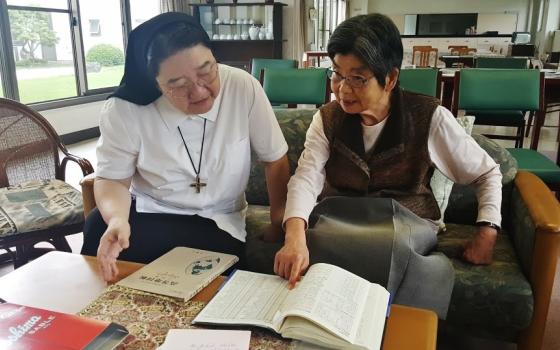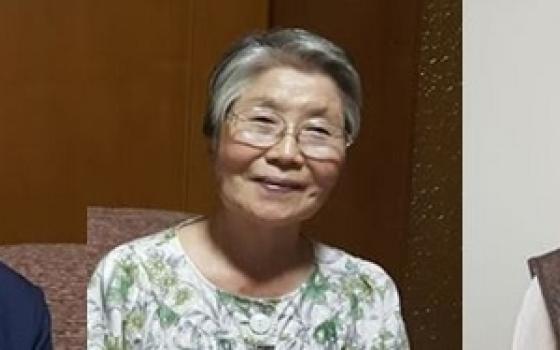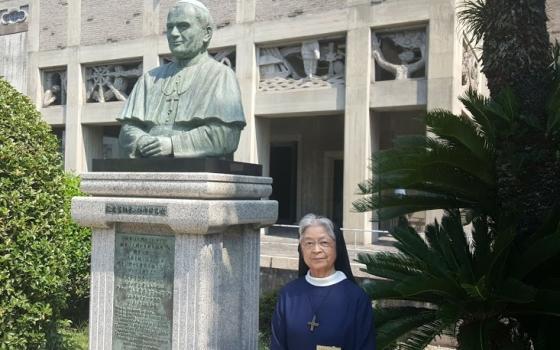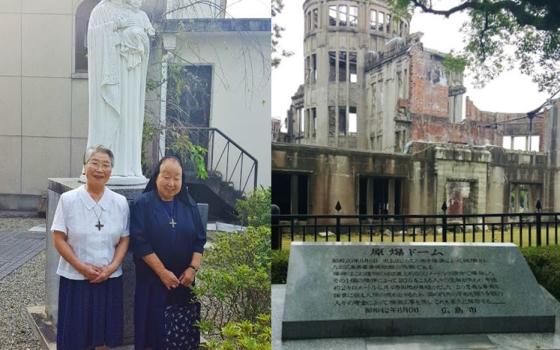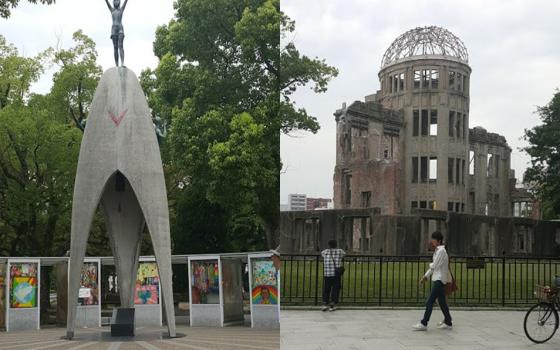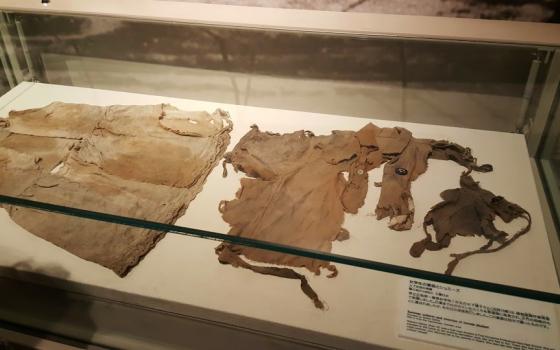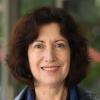The world witnessed the horror of nuclear weapons on August 6, 1945, when the United States dropped the first atomic bomb on Hiroshima at 8:15 a.m., killing about 80,000 people instantly.
By December of that year, the death toll in Hiroshima rose to about 140,000, including those who had died in fires and from injuries and radiation sickness. Hiroshima city officials say the toll exceeds 290,000 if the count includes those who died after December 1945 of nonacute injuries or radiation poisoning.
On August 9, 1945, three days after the bombing of Hiroshima, the United States dropped another atomic bomb on Nagasaki, killing more than 70,000. Thousands more from both attacks suffered with lingering health problems.
While in Hiroshima a few months ago, I interviewed five sisters: three who witnessed the attack and are hibakusha, victims who survived the bombing; one who arrived in the devastated city two days later and also is considered a hibakusha; and one who came to Hiroshima as a small child just six months after the attack. They shared their memories of that day and how it shaped their lives and vocation. In some cases, it was the first time they had heard each other's experiences. January 1 is the Catholic observance of World Day of Peace.
Sr. Agnes Eleanor Kazuko Hirota, 76, Sisters of Notre Dame de Namur
She was 5 years old and playing outside with friends when the bomb dropped.
The house cracked, and she remembers suddenly being under the house.
"If I stayed still there, we could all have been dead, but I saw a slight, dim light, so we walked," Hirota said.
She led her playmates toward the light to a nearby river. Her mother came looking for her and found her near the river, where her father also reunited with them. She lost track of what happened to her friends. She would learn later that she was the only survivor.
"As we were there at the river, the oily rain, the black rain came," Hirota said. The dark rain, which fell for about 30 minutes after the mushroom cloud formed above Hiroshima, contained soot and dust with radioactive particles from the bomb.
Hirota, her father and her mother went to a nearby tree to take cover. Hirota's mother was badly injured by falling debris, and her brother brought his friends to carry her mother on a stretcher. She was so little that others could carry her, Hirota said.
While she was waiting for her older brother, people kept going into the river for water. Many who went into the river died — some by drowning, some from severe injuries and others from shock.
"That is something I always carry in my heart: All my friends are gone. God must be requiring me to live differently," Hirota said. "So that has always been my question. What is my mission? What is it I have to accomplish?"
On August 8, "we lost our mother. She called me to her side and told me her last message: to stay strong," Hirota said.
The next day, her father died.
"My father asked me for a glass of water, I brought it to him, he drank the water and passed away," she said.
Her brother and sister weren't able to be with her parents in their last moments.
"At a young age, I got to see death, and I understand what it is like to die," Hirota said. "I'm not very scared of death. It is very quiet, it is very austere."
Without her parents, life was difficult for Hirota. Her oldest brother was 20 and took care of her and her sister. He sent Hirota and her sister to a Catholic school instead of a public one because it offered a better education.
"I took it as a calling, and I became a nun," Hirota said.
Her brother had four children, so it couldn't have been easy to pay the tuition, she said.
"God has always protected me all the way up to now," she said.
She said she was less than a half-mile from the epicenter of the bombing and is grateful she has never been hospitalized with any effects from it. At 76, "I am still up and standing and teaching in kindergarten and thankful for the things I can do."
Throughout her work as a teacher, Hirota said she has felt called to convey the message of peace to her students.
"Where there is justice, there is peace," she tells her kindergarten students.
"I tell the children their quarrels are little wars — even at that young age, they need to learn to make peace," Hirota said.
"We can grow peace," she said. "It's the peace that we should pass down to generations."
Sr. Anna Cecilia Yukie Sakimura, 80, Sisters of Notre Dame de Namur
Sakimura, then 9, had been evacuated to her aunt's house outside the city before the bomb dropped. Many parents sent their children to the countryside to protect them during the war.
She saw the mushroom cloud over Hiroshima, then learned that something awful had been dropped. On the path near her aunt's house, she saw people walking or being carried on stretchers to get away from the city.
Because her family was in the city, "I was really worried about the mushroom cloud." So on August 9, she and an older cousin took a train into what was left of Hiroshima. Amid the vast devastation, she remembers seeing an iron bridge that had fallen and others that were half destroyed.
Her father was away for work in Iwakuni, about an hour from Hiroshima. Her mother and two older sisters were in the city when the bomb fell. Her oldest sister was rescued from a building that had collapsed, but a friend her sister had been with died instantly.
Her brother, who was a soldier in charge of telecom operations, had been walking to the train station when the bomb dropped. His body was never found.
In the years after the bombing, Sakimura's family lived near a Christian family in Hiroshima that hosted a study group with a German priest. Because of their relationship with the Christian family, Sakimura's family, which had practiced Buddhism, became Christian.
When she was 13, Sakimura decided she wanted to be baptized, but her parents said she was too young. She waited a year and was baptized when she was 14. Her calling to consecrated life came thanks to Sunday school at the Hiroshima Peace Cathedral. Her older sister also decided to become a sister.
"I read about saints, and the most touching was Francis of Assisi" because of his peaceful and gentle nature, Sakimura said.
"My calling was to be part of this religion," she said.
Sr. Lucia Joseph Akie Aratani, 82, Sisters of Notre Dame de Namur
At the time the atomic bomb exploded, she was 11 years old. She was attending a school just outside the city but would return to her house near the Hiroshima train station after.
School started at 8 a.m., but the students had to be at school at 7 a.m. to work in the school's garden. On the morning of August 6, the students had done their hour of farming work and were on the second floor of the school in their classroom. Class was about to start.
Aratani was seated in the front row. She remembers seeing her teacher standing up from her desk and going to the podium, and "all of a sudden, there was a flash with a beautiful orange color — bright orange. It was very transparent. . . . I turned my head to the other side and from the window, the white building across the way turned blue from the light. Then all of a sudden, bam! A great sound and all the windows fell with a great noise."
"I was so scared," Aratani said. "I was crazy enough to run away from the site."
She took her backpack with her lunch and her school helmet and ran. She had to be careful walking because of the holes in the floor, and there was shattered glass everywhere.
She ran to her teacher's house near the school.
"My mother told me she would come [if there was an emergency], so I just waited at my teacher's house," Aratani said.
She went into a storage house and saw her teacher's brother and others coming up on a hill. She saw people were injured and burned, with some being carried on stretchers.
At that point, "I'm expecting my parents to come find me," Aratani said. Her teacher, who wanted to find out what happened to the students, came looking for her. The school was rearranged as an emergency center.
She remembers one scene in particular at the emergency center: "One mother was trying to take care of her baby, trying to feed her. But she was greatly burned and shaking. She was all black and red and must have been in great pain but needing to feed the baby. But the baby wasn't moving. That scene stays in my mind. I don't forget, even now."
Before the light fell, she and some friends wanted to go home, so they walked part of the way to Hiroshima but were sent back — the city was in flames. She stayed at her teacher's house, then later went up in the mountains to the relatives of her teachers.
"We were looking at the city burning," Aratani said.
She remembers seeing soldiers on the road, some lying down without hats or hair. They were asking for water. She remembers someone shouting that if the victims were given water, they would die. (Although they were not aware that a nuclear weapon had been used, they had watched people die from shock shortly after being given water.)
Her sister found her with the teacher's relatives. "Our houses were all burning — still burning the whole week. A tree trunk kept burning for a week downtown. We're still in wartime, so the fighter jets were still coming."
"From August 7 on, the city was filled with the stench of death," Aratani said. The bodies were covered with maggots and flies. Three days later, group cremation began.
After the bombing, many priests came to Hiroshima. Aratani's sister decided to get baptized and took Aratani to church and to catechism class.
A very famous German priest, Fr. Hubert Cieslik, was among a small group of Jesuit priests in Hiroshima who survived the bomb.
"He was a very gentle man," Aratani said.
The priest spoke in slow Japanese, but Aratani loved his sermons. She didn't like Mass at first — it was in Latin and the priest wasn't facing the congregation. She didn't want to go at all, but he helped her understand it.
She was baptized, and her mother came to the ceremony in a kimono. Aratani still has a card from her baptism.
"It was a grace from God, and I fell in love with prayer," she said.
Every morning, she would go to Mass with her sister, walking to the church and to school. She was very impressed with the Catholic sisters who taught and cared for them.
"I wanted to be a sister — from the blood of my heart," she said. "They took care of us. I never had any doubt."
Sr. Estelle Kazuko Takabayashi, 90, Sisters of Notre Dame de Namur
After high school, at age 19, Takabayashi was sent to a factory in Kurashiki, where she was when the bomb dropped in Hiroshima, where her mother and brothers lived. (Her father had died of a cerebral hemorrhage when she was 10 years old.)
She decided to try to go to the city on August 7, taking trains from the countryside into the city in a roundabout way. She arrived August 8. There was no train station and no buildings. Soldiers were trying to clear the streets. She remembers seeing one lady who must have been beautiful, as she was an officer's wife, but she looked like a ghost. She was carrying bones in her hands — her father's bones, the lady told her.
She tried to find her mother. Their home had been near a school in the central part of the city where the Peace Park now is. Her mother, she heard later, had gone on an errand to what would become the hypocenter and must have died in the blast. Her body was never found.
She passed a swollen corpse that looked like a horse. As she walked along the railroad, she met many Koreans who had been working in the area who were crying because they had lost their families. She arrived in west Hiroshima and met up with her elder brother.
Her younger brother had been injured breaking up houses to stop the fires that raged in Hiroshima after the bomb. He was taken to a relative's house in the hills, where there was a long line to see the doctor, who could do nothing to help people. Takabayashi and her brother went back home, and he died on August 11.
"I said, 'Stop, do not go,' but he got colder and colder," she said. "I cannot forget the experience of death itself. Even now, I feel something."
A few years later, Takabayashi began teaching at a Catholic school, Notre Dame Seishin High School in Hiroshima.
Her whole family was Buddhist, but she decided to study the catechism. She went on a retreat and was baptized in 1951. She entered the convent in 1955.
She says she has put her life in God's hands. "I accept from God everything, and that has given me peace," Takabayashi said.
"There is tragic news every day with terrorist attacks," she said. She said she gets peace from faith: "People have forgotten [getting peace through faith] because there is confusion and terrible things still happening in the world."
Sr. Maria Teruko Onojima, 74, Society of the Helpers of the Holy Souls
Onojima is Japanese but was born in Taiwan during the Japanese occupation. When she was 3 years old, just six months after the United States dropped the bomb, Onojima's mother moved her and her 2-year-old brother to the suburbs of Hiroshima to join their grandparents, who had lost everything in the bombing.
Her classmate, Sadako Sasaki, died of leukemia 10 years after the bomb at the age of 11. Her story is immortalized in Children's Peace Monument as well as in the symbol of paper cranes: Sasaki believed folding paper cranes would help her recover, and she kept making them during her eight-month fight with the disease.
When Sasaki was hospitalized, "we started making cranes. It was very serious leukemia, so we tried to join her wish. All of us made cranes."
Onojima's grandparents were very religious, she said. Onojima remembers her grandmother telling her: "You have to look for your own God."
"So that was my assignment. That's what I was looking for," Onojima said.
She first went to the Protestant church, but by her first year of senior high school, she was studying with a Jesuit priest who was a pastor in Hiroshima. He introduced her to a sister who was a Helper of the Holy Souls. She was baptized at 18, and at 25, she decided to join the Helpers of the Holy Souls community.
As part of the international congregation, Onojima was sent the Philippines in 1979 during the dictatorship of Ferdinand Marcos. She lived in a very depressed area to help build the Christian community. When she introduced herself, she would say she was from Hiroshima.
"They don't know much about Japan, but they know about Hiroshima," Onojima said.
After 10 years in the Philippines, she went to the United States for five years then returned to Japan.
"Little by little, [working with hibakusha] became a special mission," she said. "For me, this is natural."
The Society of Helpers was the only congregation in Hiroshima before World War II, so when the Memorial Cathedral for World Peace was built, the center asked them to send a sister to help manage the church. Since then, sisters of the Society of Helpers have worked at the cathedral, and it is now Onojima's turn. She has provided spiritual direction and support to hibakusha at the Cathedral for World Peace for 23 years.
"There are so many people seeking the meaning of life and are really suffering," Onojima said.
After World War II, "many adults didn't have any inner care" — emotional, psychological or spiritual counseling, she said. Adults could not express their feelings even to their families, so relationships with children and parents become strained.
"When I started working here, many were looking for someone to tell their stories, so I continued listening to the stories," she said. She is not a psychologist but studied spiritual direction and accompaniment in Chicago. "My experience in the Philippines and the States and international congregation and that international experience is very helpful."
"For many years, [survivors] didn't want to talk about the war or their experiences," she said. "But now, they want to talk."
[Gail DeGeorge is editor of Global Sisters Report. Her email address is gdegeorge@ncronline.org. Follow her on Twitter @GailDeGeorge. Thanks to Mariko Komatsu and Sr. Masako Miyake of the Sisters of Notre Dame de Namur for their help in telling these stories.]
Related on GSR - On World Day of Peace, recognizing those who work for nuclear disarmament
Related on NCRonline - An interview with a survivor of the Hiroshima bombing
